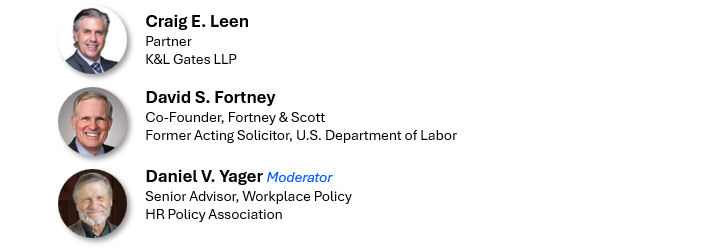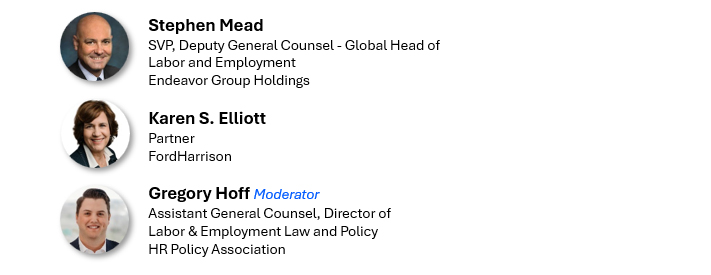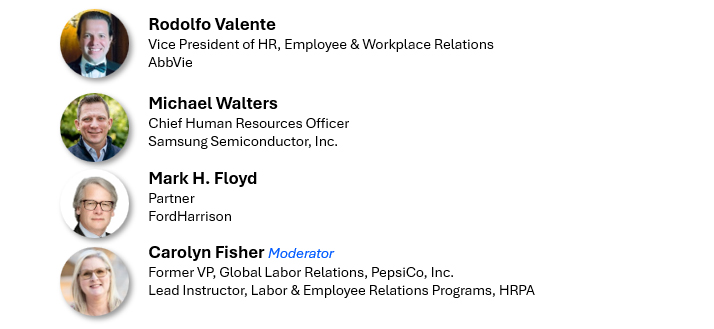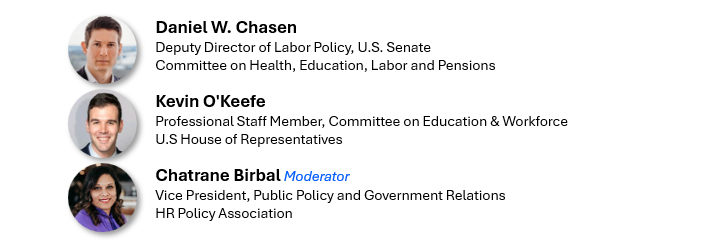HRPA’s Employment and Labor Group annual conference convened senior leaders from across the labor and employment landscape to discuss workforce policy and the future of labor and employee relations. The event brought together top CHROs, labor relations professionals, and Congressional staff to exchange insights and discuss forward-looking strategies.
The agenda covered pressing and complex topics, including how to navigate the expanding patchwork of state laws, respond to global policy shifts, and evaluate the impact of Trump administration workplace policies alongside current Congressional priorities. Attendees left with a clearer understanding of the evolving national and international labor policy landscape—and a stronger network to help influence what lies ahead.
New Workplace Dynamics Demand Updated Employee Relations Strategy
Traditional labor relations are rapidly fading. Today, companies are reimagining their approach by factoring in the influence of social media and the need for continuous communication with all employees, whether unionized or not.

Key panel takeaways:
Communication imperative: Paul Lalli, newly minted in his job at CVS Health, made one of his first objectives to re-combine the labor and colleague relations teams. In order for labor relations to be part of the larger goals of the company, “you need a consistent message in both employee relations and labor relations spaces.” This reflects significant review and restructuring of HR organizational structures.
Developing the new generation: Michael Fitzsimmons highlighted the impacts of the workforce generational shift and social media which puts more demands on company communication. Companies “must think strategically about the development of new employee and labor relations professionals and make sure there is experiential learning.”
AI and organizing: Heidi Capozzi identified the impact AI will have on employees and the need to educate leadership on organizing—especially in industries that are currently unfamiliar with unions. AI raises the question of “how we will reskill employees but, more importantly, how we will talk to them about AI.”
The bottom line: Diverging generational expectations, concerns about AI among both blue- and white-collar workers, and evolving DEI strategies are contributing to a heightened sense of vulnerability among employees. Building strong partnerships between labor relations, employee relations, and HR is essential to develop strategies that improve communication and foster greater awareness across the workforce.
Trump Administration Workplace Priorities
Attendees heard insights from former senior administration officials and prominent labor influencers on the future of the Trump administration’s workplace policy agenda. Panel discussions covered enforcement priorities and regulatory changes, offering an inside perspective on the developments poised to reshape the workplace—and how employers can engage proactively to help guide priorities and inform next steps.
Key panel takeaways:
Building from the ground up: The Trump administration is honing its priorities with a genuine will to re-imagine initiatives like apprenticeships, as well as structure or eliminate familiar offices, like the OFCCP.
Opinion letters reinstated: The DOL has reinstated its opinion letter program, allowing employers to submit questions about how federal labor laws apply to specific situations and receive official written interpretations from the agency. If an employer’s practices are later challenged, these letters can serve as evidence that the employer acted in good faith and help demonstrate compliance with the law.
Revamping regulations: The DOL is prioritizing guidance and safe harbor provisions to help employers minimize the risk of litigation. As part of a broader effort to streamline regulations, the agency is also leveraging AI to identify and reassess existing rules that may exceed its statutory authority.
Desire for program longevity: Apprenticeships were re-envisioned and expanded under the first Trump administration, but that effort was wholly disassembled under the Biden Administration. Attendees voiced strong interest in developing an apprenticeship framework durable enough to withstand changes in presidential administrations.
Advancing DEI Goals Requires Smart, Legally-Sound Approach
In this panel, corporate practitioners joined employment lawyers, David Fortney and Craig Leen, to discuss the current state of DEI, potential pitfalls to avoid, and what the future may hold for DEI and talent strategies.

Key panel takeaways:
Illegal DEI undefined: As we know, the Trump Administration’s executive order mentions “illegal DEI” but does not define it. When asked how they define it, panelists redirected the question - with the ideology of DEI being a political flashpoint, any type of preference program is now potentially at risk.
While non-discrimination laws and regulations have not changed, social perspectives have and that is what companies are navigating today.
Change in direction: The Equal Employment Opportunity Commission (EEOC)’s recent targeting of 20 major law firms and requesting information on their DEI programs demonstrates approaches that may be expanded to companies and others.
Public naming is a new strategy - none of the law firms were formally charged. Instead, EEOC sent the letter and made it public.
Challenge to agency independence: As we shared last week, during her Senate HELP Committee nomination hearing, the EEOC’s Acting Chair stated that President Trump should ultimately have final authority over the agency’s actions when asked about the extent of presidential influence on the EEOC.
Encouraging whistleblowers and empowering the False Claims Act: Government agencies are encouraging whistleblowers to report potential DEI-related discrimination to the EEOC. With the requirement for federal contractors to “certify that it does not operate any programs promoting DEI that violate any applicable Federal anti-discrimination laws,” contractors must conduct careful due diligence before certifying.
What’s ahead: Panelists agreed that tension exists and companies may encounter recruitment challenges. But CHROs ended on an optimistic note, “As long as your culture is set, employees will navigate the language change—people understand ‘belonging’ and ‘inclusion.’”
Panel Reveals Successful Strategies For State Law Compliance
Multistate employers face significant challenges navigating the growing patchwork of state laws. Regulations covering AI, paid leave, independent contractor status, captive audience meetings, non-competes, and pay transparency—among others—are forcing companies to assess when they’ve reached a tipping point where adopting a national strategy is more practical than managing compliance on a state-by-state basis.

Identifying your tipping point: Stephen Mead encouraged employers to evaluate each topic independently by asking, “If we comply with the strictest law, how does that impact us?”
As an example, Mr. Mead compared including pay ranges on job postings nationwide and paid leave policies — including pay ranges everywhere did not cost the company more and, in fact, led to a kind of self-audit and the ability to correct. Paid leave, on the other hand, is more often handled state-by-state due to cost.
Panelists also provided tips on specific state law issues:
On captive audience bans: Twelve states have bans and some are being challenged in court. Panelists recommended companies continue to have voluntary meetings but look for other ways to get your information to the workforce through social media and internal communications, panelists advised.
On AI: This area is moving fast and while the legal parameters continue to be defined at the state level, it is important to choose good AI vendors and know how their tools work. One tactic for evaluating AI hiring recruitment tools is to evaluate who you are getting in the door for interviews.
On non-competes: Karen Elliott advised, “Make sure your non-confidentiality agreements are not so broad that they become non-competes.” Citing a client whose employees left with links to the cloud where company information resided, she added, “If you have data, you really want to protect, understand the best way to do so.”
Global Employers Face Dynamic Regulatory Environment
Countries around the world have adopted new rules, highlighting the pressure for global employers to stay ahead of fast-moving regulatory change. Panelists shared how they’re building cohesive cross-border strategies and structures that support both compliance and business goals. Attendees left with a clearer understanding of the global policy landscape—and how to navigate it with confidence.

Key panel takeaways:
Consistent narratives are key: “Internationally, you have to stick to your narrative. One must define, what is our Narrative, how do we develop that Narrative, and How do we complete that narrative?” stated Mark Floyd, asking, “What is your ‘center post?’ What is the thing you can grab on to within your company to not be blown away by a tornado of change.”
Communication is integral to success: “We are global companies, with regional knowledge bases,” stated Rodolfo Valente, “Make sure your middle management and labor leaders are read in on current workforce issues.”
Carolyn Fisher asked what is the most important issue for global employers was, and the response was emphatic:
Culture is the core with AI: “From a global perspective, the regulatory landscape is very much the same as the U.S., with similarly shifting policy and political landscapes,” commented Michael Walters. Companies must ask if their plan on integrating AI is about bringing down the headcount, or increasing capability.
Have a plan: With things like the the EU’s AI act, you must be close to the authorities,” warned Mr. Valente, Mr. Floyd adding that, “You have to have a plan in place for potential AI attacks and fakes.” Be prepared for generated material about c-suite individuals or anyone in your employ.
Congressional Staff Share Capitol Hill’s Workplace Policy Priorities
Congressional staff provided insight into what the House and Senate are focusing on now and the potential for workplace issues in the year ahead, providing context, and outlining possible timing.

Speaking for the Senate Health, Education, Labor & Pensions (HELP) committee, Daniel Chasen commented that the committee has “gotten through a record, if not near record, amount of nominations so far.” and that they are “waiting eagerly for NLRB nominees.”
On behalf of the House Education and Workforce committee, Kevin O'Keefe said the committee focus is on wage and hour modernization, commenting that “FLSA modernization will have to be taken in chunks, as they are able to be passed. We would love the FLSA Modernization Act to be passed tomorrow, but it is not likely.
We will most likely move forward with the bi-partisan portions first.”
Key panel takeaways:
Potential workplace issues for consideration later in the year include:
Independent contractors and portable benefits;
Legislation revising non-competes;
Legislation easing the use of Employee Stock Ownership Plans;
Joint employer legislation;
FLSA overtime modernization; and
Paid leave.
AI is unlikely to receive much Congressional attention.
Unlike the last Congress, when both the House and Senate held listening sessions to explore AI applications across the U.S., including in the workplace, no similar activity has taken place so far this year. House Education and Workforce Committee leaders recognize AI’s potential to improve worker safety but agree the technology needs clearer definitions and deeper understanding.
In the Senate, HELP Committee Chair Sen. Bill Cassidy is a strong proponent of AI, though no legislation appears imminent.
Lawmakers are aware that state legislatures are moving forward with their own AI regulations, which is why there is support for including a 10-year moratorium on new state AI laws in the House and Senate reconciliation bills.
However, it remains uncertain whether the AI provision will survive in the final reconciliation package, as some lawmakers Republicans and Democrats alike oppose restricting state authority.
WIOA still has a bipartisan agreement in place, negotiated in the last Congress, which was supposed to be passed at the end of the year, but was scuttled last minute. It is not clear whether WIOA, as written, will move forward, timelines will be impacted by the administration’s apprenticeship and One Big Beautiful Bill focus.
Rep. Kiley’s Independent Workers Security Act is a top priority for House Education and Workforce Committee Chair Rep. Tim Walberg, and independent worker classification transparency is also a key focus for Senate HELP Committee Chair Sen. Cassidy. With growing support for gig workers—and the added momentum of an approaching midterm election year—it is plausible the bill could advance in the coming year.